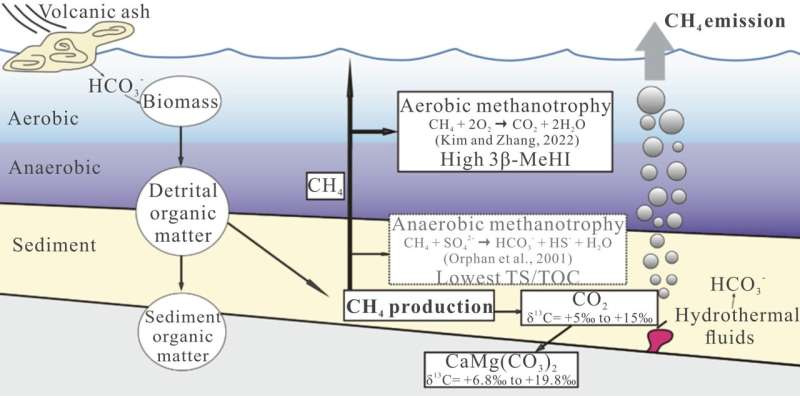August 5, 2023 feature
This article has been reviewed according to Science X's editorial process and policies. Editors have highlighted the following attributes while ensuring the content's credibility:
fact-checked
peer-reviewed publication
trusted source
proofread
Ancient lake microbes caused global warming during ice age

Global warming is not just a modern issue, but has occurred numerous times over Earth's history, with one such event happening 304 million years ago during the Late Paleozoic Ice Age (which spanned from 340 to 290 million years ago). Studies have discovered evidence of increased sea surface temperature, continental ice decline and oceanic environments flooding the land at the time.
Dr Liuwen Xia at Nanjing University, China, and collaborators researched the effect of a large injection of methane from alkaline lakes (pH 9 to 12) into the atmosphere, in work published in Geology.
Large quantities of atmospheric methane causes global warming as it is a potent greenhouse gas trapping heat 28 times more effectively than carbon dioxide over 100 years. Methane-producing microorganisms are responsible for 74% of global methane emissions, therefore defining the environmental conditions that encourage them to not only survive but thrive is important for understanding climate change.
The Junggar Basin in northwest China was investigated by assessing methane levels derived from microbial activity. The researchers took core samples from the lake bed and undertook chemical analyses of the rock to determine the type of carbon present based upon its source from aquatic green algae, cyanobacteria (photosynthesising microorganisms) and halophilic archaea (an extreme microorganisms that lives in high salt environments).
When the lake contains more dissolved inorganic carbon (a form that doesn't have carbon and hydrogen bonds) the algae, cyanobacteria and archaea preferentially take up the lighter form (carbon-12) meaning the heavier carbon-13 remains in the lake water and is deposited, leading to distinct differences in the measurements taken from the rock.
The researchers found one particular type, alkalophilic methanogenic archaea, took a competitive advantage in the low sulfate anoxic environmental conditions of the lake, preserving the heaviest carbon-13 values in the rock. This species thrived by obtaining the energy required for growth by producing large quantities of methane in the lake water, which was then released into the atmosphere. Methane emissions from microbial activity alone are suggested to have been up to 2.1 gigatons.
Carbon dioxide derived from volcanic activity and hydrothermal processes transported to the lake was converted into bicarbonate and carbonate (forms of dissolved inorganic carbon), which increased the alkalinity of the lake and is noted to enhance the creation of methane as it promotes microbial activity. Dissolved inorganic carbon provides an almost limitless supply of carbon to the algae, cyanobacteria and archaea for their metabolic processes.
Therefore, linking this increased and consistent supply of methane to the Late Paleozoic Ice Age, which had a peak in atmospheric methane 304 million years ago, may suggest that the combined contribution from numerous alkaline lakes globally could have had a significant impact on global greenhouse gas levels. The researchers suggest that, taking the lakes in northwest China alone, methane emissions could have reached 109 gigatonnes, which is equivalent to the greenhouse forcing power of up to 7521 gigatonnes of carbon dioxide.
Clearly this highlights the potency of methane in affecting our climate, and specifically the importance of identifying alkaline lakes globally to monitor their current emissions and find solutions to help combat their activity. This can include reducing the pH of the lakes so that they become more acidic, adding certain types of clay or even dredging the lake bottom, but all of these solutions naturally introduce a host of their own effects on the environment. As such, there may not yet be a clear solution to reducing methane emissions from lakes and abating their global warming potential.
More information: Liuwen Xia et al, Effects on global warming by microbial methanogenesis in alkaline lakes during the Late Paleozoic Ice Age (LPIA), Geology (2023). DOI: 10.1130/G51286.1
Journal information: Geology
© 2023 Science X Network




















